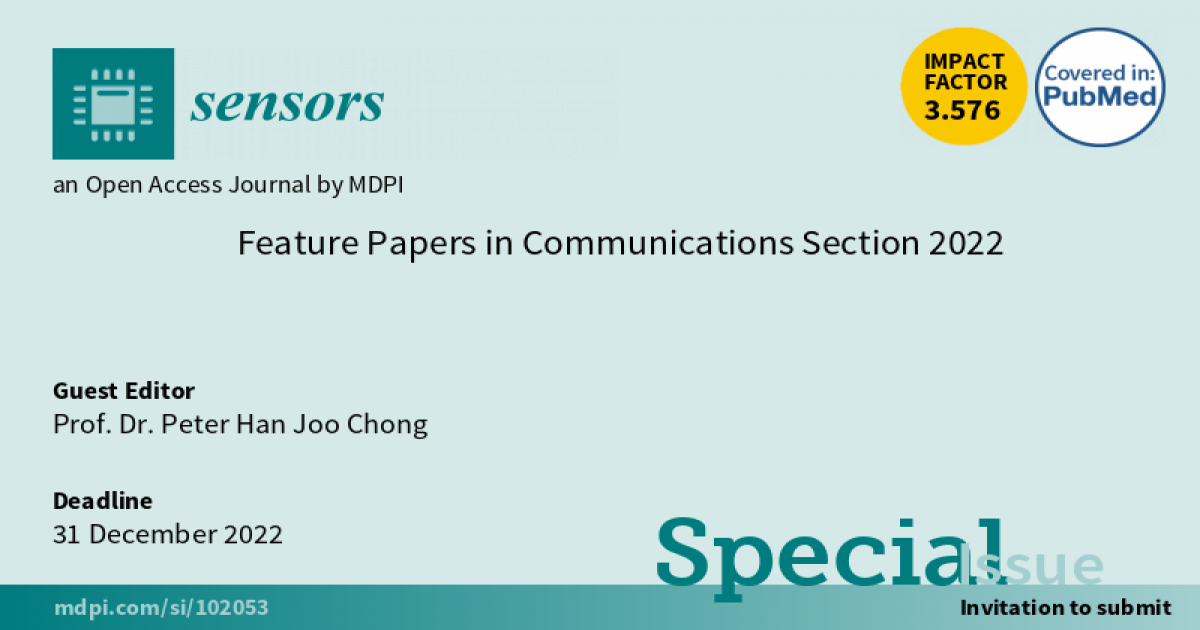- 3.5Impact Factor
- 8.2CiteScore
- 20 daysTime to First Decision
Feature Papers in Communications Section 2022
Special Issue Information
Dear Colleagues,
We are pleased to announce that the Communications Section is presently compiling a collection of papers submitted exclusively by Editorial Board Members (EBMs) of our section and outstanding scholars in this research field.
The purpose of this Special Issue is to publish a set of papers that typify the very best of insightful and influential original articles or reviews, where our section EBMs discuss key topics in the field. We expect these papers to be widely read and highly influential within the field. All papers in this Special Issue will be collected into a printed edition book following the deadline and be extensively promoted.
We wish to take this opportunity to call on more excellent scholars to join the Communications Section such that we can achieve more milestones together.
The topics of interest to this Special Issue include but are not limited to:
- Wireless communications;
- 5G/6G communication systems;
- V2X communications
- Sensor and ad hoc networks;
- Intelligent communications and networking;
- Ultrareliability and low latency communications;
- Machine-to-machine communications;
- Communication theory;
- Communication protocol design;
- Communication network security;
- Data analytics and intelligent network operation;
- Edge networks;
- Electromagnetic/radio wave propagation;
- Body area networks;
- Millimeter-wave/terahertz communications;
- RFID (radio frequency identification);
- Vehicular communications;
- Satellite communications;
- UWB (ultra-wideband) communications;
- Optical communications;
- Software-defined radio and software-defined networking;
- MIMO/NOMA communications;
- Emerging communication technologies.
Prof. Dr. Peter Chong
Guest Editor
Manuscript Submission Information
Manuscripts should be submitted online at www.mdpi.com by registering and logging in to this website. Once you are registered, click here to go to the submission form. Manuscripts can be submitted until the deadline. All submissions that pass pre-check are peer-reviewed. Accepted papers will be published continuously in the journal (as soon as accepted) and will be listed together on the special issue website. Research articles, review articles as well as short communications are invited. For planned papers, a title and short abstract (about 100 words) can be sent to the Editorial Office for announcement on this website.
Submitted manuscripts should not have been published previously, nor be under consideration for publication elsewhere (except conference proceedings papers). All manuscripts are thoroughly refereed through a single-blind peer-review process. A guide for authors and other relevant information for submission of manuscripts is available on the Instructions for Authors page. Sensors is an international peer-reviewed open access semimonthly journal published by MDPI.
Please visit the Instructions for Authors page before submitting a manuscript. The Article Processing Charge (APC) for publication in this open access journal is 2600 CHF (Swiss Francs). Submitted papers should be well formatted and use good English. Authors may use MDPI's English editing service prior to publication or during author revisions.

Benefits of Publishing in a Special Issue
- Ease of navigation: Grouping papers by topic helps scholars navigate broad scope journals more efficiently.
- Greater discoverability: Special Issues support the reach and impact of scientific research. Articles in Special Issues are more discoverable and cited more frequently.
- Expansion of research network: Special Issues facilitate connections among authors, fostering scientific collaborations.
- External promotion: Articles in Special Issues are often promoted through the journal's social media, increasing their visibility.
- e-Book format: Special Issues with more than 10 articles can be published as dedicated e-books, ensuring wide and rapid dissemination.

